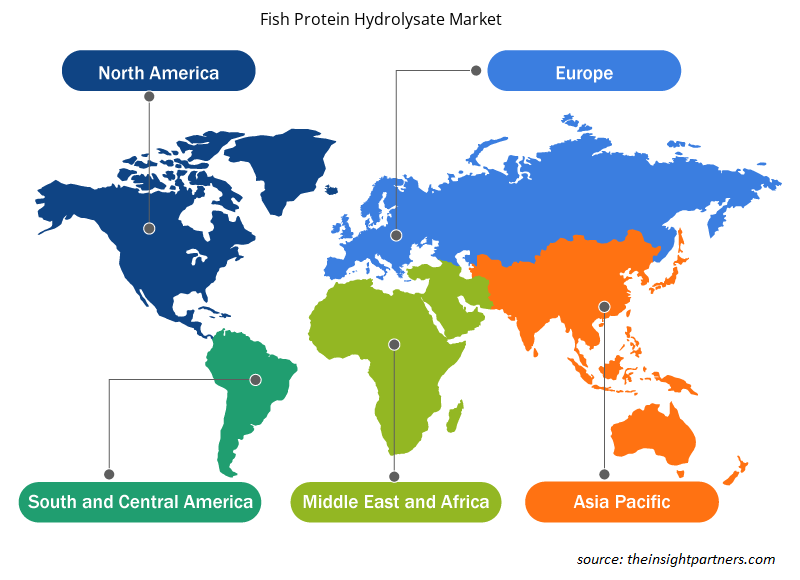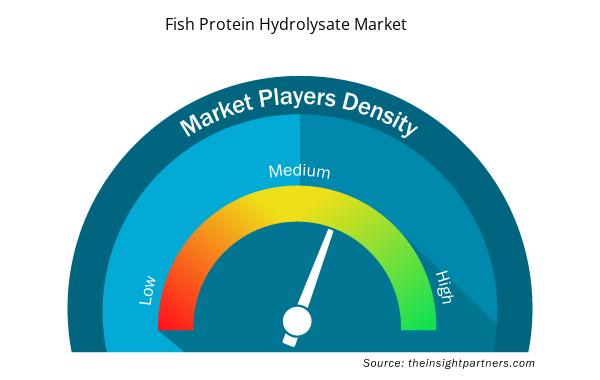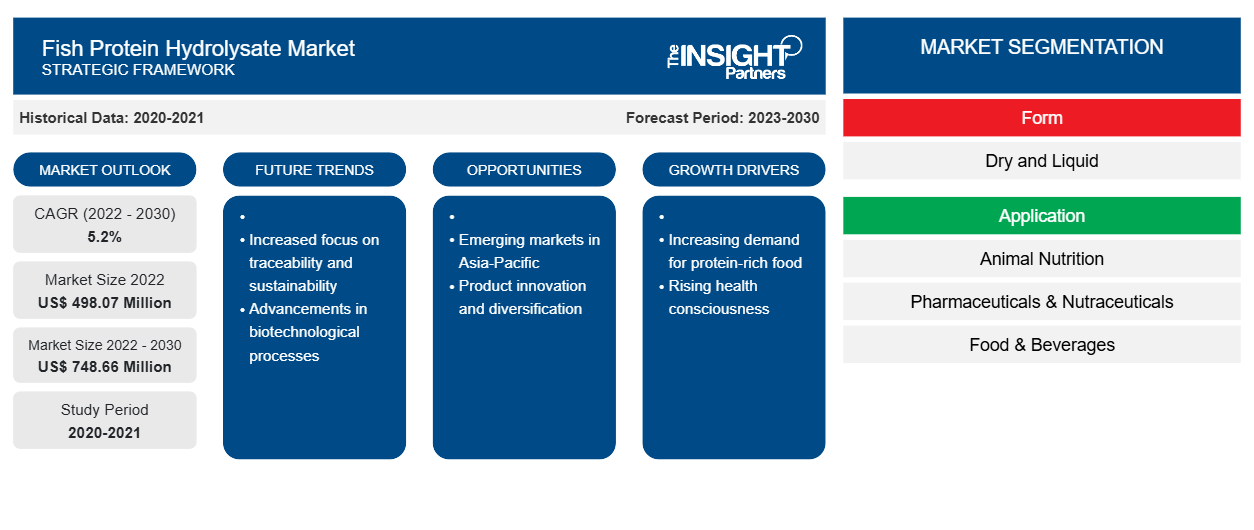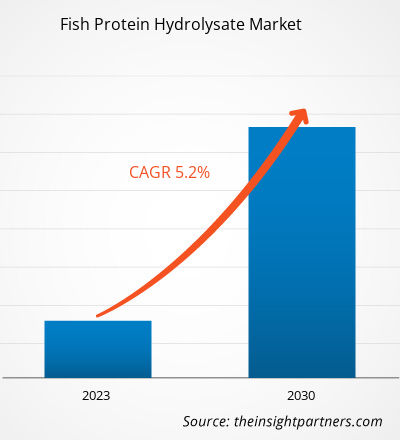[Forschungsbericht] Der Markt für Fischproteinhydrolysate soll von 498,07 Millionen US-Dollar im Jahr 2022 auf 748,66 Millionen US-Dollar im Jahr 2030 wachsen; von 2022 bis 2030 wird eine durchschnittliche jährliche Wachstumsrate (CAGR) von 5,2 % erwartet.
Markteinblicke und Analystenansichten:
Fischproteinhydrolysat ist ein Produkt, das aus Fisch oder Fischmaterial durch Proteinhydrolyse hergestellt wird. Fischproteinhydrolysat ist also eine Mischung aus aufgebrochenen Proteinen. Fischproteinhydrolysate sollen im Vergleich zum Ursprungsprotein eine Reihe verbesserter Eigenschaften aufweisen, nämlich verbesserte funktionelle Eigenschaften und bioaktive Eigenschaften wie antioxidative oder blutdrucksenkende Wirkung. In letzter Zeit wird Fischproteinhydrolysat auch als Kryoprotektivum für gefrorene Fischprodukte verwendet. Diese Faktoren werden voraussichtlich das Wachstum des Fischproteinhydrolysatmarktes im Prognosezeitraum vorantreiben.
Wachstumstreiber und Herausforderungen:
Aufgrund der Entwicklung von Fischereitechnologien wächst die Produktion in der Fischerei- und Aquakulturindustrie rasant. Mit der steigenden Produktion in der Fischerei auf der ganzen Welt fallen erhebliche Mengen Fischabfälle an. Laut dem National Institute of Biotechnology Information (NCBI) werden etwa zwei Drittel der gesamten Fischproduktion als Abfall entsorgt. Fischabfälle können durch Zugabe verschiedener proteolytischer Enzyme in Mehrwertprodukte wie FPH umgewandelt werden. Haut, Kopf, Knochen, Eingeweide und Leber von Fischabfällen sind eine gute Quelle für Aminosäuren, Antioxidantien, Proteine und Peptide. Es wurde auch festgestellt, dass die Abfälle wünschenswerte bioaktive und funktionelle Peptide enthalten. Daher legen Unternehmen großen Wert darauf, Fischabfälle als Protein für verschiedene Branchen zu verwenden, darunter Lebensmittel und Getränke, Tierfutter und Nutrazeutika. Die zunehmende Menge an Fischabfällen durch Aquakultur und Fischerei treibt das Wachstum des Marktes für Fischproteinhydrolysate weiter voran.
Darüber hinaus ist FPH eine gute Protein- und Nährstoffquelle wie Phosphor, Kalzium und andere Mineralien. Es hilft, die Ausbreitung von Infektionskrankheiten zu verhindern und stärkt die Immunität der Tiere gegen Pilze, Bakterien, Viren und Parasiten. Der regelmäßige Verzehr von FPH durch Masthühner fördert deren Muskelaufbau. FPHs können den Stoffwechsel der Tiere verbessern und sie so vor Krankheiten und Infektionen schützen. Die ernährungsphysiologischen Vorteile von Fischproteinhydrolysat in Bezug auf die Tiergesundheit treiben daher seine Nachfrage in der Tierfutterindustrie an.
Das Fehlen eines gut organisierten Sammel-, Lagerungs- und Transportmodells schafft jedoch weitere Hürden, wodurch Fischnebenprodukte verschwendet werden können. Darüber hinaus verhindern unvorhersehbare Hindernisse den reibungslosen Ablauf der Lieferketten für frische Lebensmittel, was zu Verschwendung und eingeschränkter Marktnachfrage führt.
Passen Sie diesen Bericht Ihren Anforderungen an
Sie erhalten kostenlos individuelle Anpassungen an jedem Bericht, einschließlich Teilen dieses Berichts oder einer Analyse auf Länderebene, eines Excel-Datenpakets sowie tolle Angebote und Rabatte für Start-ups und Universitäten.
- Holen Sie sich die wichtigsten Markttrends aus diesem Bericht.Dieses KOSTENLOSE Beispiel umfasst eine Datenanalyse von Markttrends bis hin zu Schätzungen und Prognosen.
Berichtssegmentierung und -umfang:
Der globale Markt für Fischproteinhydrolysate ist nach Form, Anwendung und Geografie segmentiert. Nach Form wird der Markt in trocken und flüssig unterteilt. Nach Anwendung wird der Markt in Tierernährung, Lebensmittel und Getränke, Pharmazeutika und Nutraceutika , Körperpflege und Landwirtschaft segmentiert. Darüber hinaus wird das Segment Tierernährung in Geflügel, Wiederkäuer, Schweine, Aquakultur, Haustiere und andere unterteilt. Der Markt für Fischproteinhydrolysate ist nach Geografie segmentiert in Nordamerika (USA, Kanada und Mexiko), Europa (Deutschland, Frankreich, Italien, Großbritannien, Russland und der Rest von Europa), Asien-Pazifik (Australien, China, Japan, Indien, Südkorea und der Rest von Asien-Pazifik), den Nahen Osten und Afrika (Südafrika, Saudi-Arabien, die Vereinigten Arabischen Emirate und der Rest von Nahem Osten und Afrika) und Süd- und Mittelamerika (Brasilien, Argentinien und der Rest von Süd- und Mittelamerika).
Segmentanalyse:
Basierend auf der Form ist der Markt für Fischproteinhydrolysat in trocken und flüssig unterteilt. Das Trockensegment hält einen größeren Marktanteil. Die Nachfrage nach Fischproteinhydrolysat in Pulverform ist aufgrund der längeren Haltbarkeit und des einfacheren Transports und der Lagerung höher als in flüssiger Form. Diese Faktoren treiben das Marktwachstum im Pulversegment voran.
Regionale Analyse:
Geografisch ist der Markt für Fischproteinhydrolysat in fünf Hauptregionen unterteilt: Nordamerika (NA), Europa (EU), Asien-Pazifik (APAC), Süd- und Mittelamerika sowie Naher Osten und Afrika. Der Asien-Pazifik-Raum dominiert den globalen Markt für Fischproteinhydrolysat; der Markt in dieser Region wurde im Jahr 2022 auf 170 Millionen US-Dollar geschätzt. Der Markt in Europa wird im Prognosezeitraum voraussichtlich eine durchschnittliche jährliche Wachstumsrate von 4,8 % verzeichnen. Industrie- und Entwicklungsländer im Asien-Pazifik-Raum erleben ein Wachstum der Urbanisierung, gepaart mit einer wachsenden Mittelschichtbevölkerung, was den Marktteilnehmern zahlreiche Chancen bietet. Faktoren wie die gestiegene Nachfrage nach Proteinpräparaten gepaart mit der zunehmenden Verwendung von Fitnessprodukten für den persönlichen und sportlichen Bereich treiben die Nachfrage im Asien-Pazifik-Raum an.
Nordamerika hat mit einem Marktanteil von fast 30 % den zweitgrößten Anteil am Markt für Fischproteinhydrolysate. Die Verbraucher in den USA und Kanada setzen auf einen gesunden Lebensstil und bevorzugen Produkte, die gesundheitliche Vorteile bieten. Die zunehmenden Gesundheitsbedenken der Verbraucher treiben daher das Wachstum des nordamerikanischen Marktes für Fischproteinprodukte voran. Die gesundheitlichen Vorteile sowohl tierischer als auch pflanzlicher Nahrungsquellen tragen dazu bei, das Energieniveau zu steigern, die Muskel- und Knochenstruktur zu stärken und die Konzentration zu verbessern, neben einer Reihe anderer gesundheitlicher Vorteile. Daher tendiert diese Region zur Aquakulturernährung. Aus diesem Grund steigt die Nachfrage nach Fischproteinhydrolysat in Nordamerika.
Branchenentwicklungen und zukünftige Chancen:
Nachfolgend sind die Initiativen der wichtigsten Akteure auf dem Markt für Fischproteinhydrolysate aufgeführt:
- Im Mai 2021 kündigte die Biomega Group, ein führendes Biowissenschaftsunternehmen, das Meereszutaten herstellt, die Erweiterung ihres Bioraffinerie-Fußabdrucks durch die Investition in einen neuen Greenfield-Standort in Hirtshals, Dänemark, an. Ziel der Investition war die Erweiterung der Produktionskapazität des Unternehmens.
Auswirkungen der COVID-19-Pandemie:
Die COVID-19-Pandemie hat sich negativ auf fast alle Branchen in verschiedenen Ländern ausgewirkt. Lockdowns, Reisebeschränkungen und Betriebsschließungen in Nordamerika, Europa, im asiatisch-pazifischen Raum, in Süd- und Mittelamerika sowie im Nahen Osten und Afrika behinderten das Wachstum mehrerer Branchen, darunter Lebensmittel und Getränke, Pharmazeutika und Nutraceutika, Körperpflege, Tiernahrung usw. Die Schließung von Produktionseinheiten störte die globalen Lieferketten, Produktionsaktivitäten, Lieferpläne sowie den Verkauf lebenswichtiger und nicht lebenswichtiger Produkte. Verschiedene Unternehmen erlebten im Jahr 2020 Verzögerungen bei Produktlieferungen und einen Einbruch ihrer Produktverkäufe, was den Markt für Fischproteinhydrolysate behinderte. Der Mangel an Arbeitskräften und die begrenzte Versorgung mit Rohstoffen führten während der COVID-19-Pandemie auch zu einem Stillstand von Betrieben und Prozessen auf der ganzen Welt. Diese Faktoren wirkten sich während der Pandemie negativ auf das Marktwachstum aus.
Verschiedene Handelsbarrieren, die von Regierungsbehörden verhängt wurden, um die Ausbreitung von COVID-19 zu verhindern, behinderten den Import von Rohstoffen. China, Vietnam, Indien, Bangladesch und Ägypten gehören zu den wichtigsten Rohstoffproduzenten, was zu einer Abhängigkeit von diesen Ländern in anderen Teilen der Welt führt. Verbote internationaler Importe und Exporte in vielen Ländern unterbrachen die Rohstoffversorgung während der COVID-19-Pandemie.
Im Jahr 2021 nahmen jedoch viele Volkswirtschaften ihren Betrieb wieder auf, da mehrere Regierungen die zuvor verhängten Beschränkungen aufhoben, was sich positiv auf den Weltmarkt auswirkte. Darüber hinaus durften die Hersteller mit voller Kapazität arbeiten, was ihnen half, die Nachfrage- und Angebotslücken zu überwinden.
Regionale Einblicke in den Markt für Fischproteinhydrolysate
Die regionalen Trends und Faktoren, die den Markt für Fischproteinhydrolysat im Prognosezeitraum beeinflussen, wurden von den Analysten von Insight Partners ausführlich erläutert. In diesem Abschnitt werden auch die Marktsegmente und die Geografie für Fischproteinhydrolysat in Nordamerika, Europa, im asiatisch-pazifischen Raum, im Nahen Osten und Afrika sowie in Süd- und Mittelamerika erörtert.

- Erhalten Sie regionale Daten zum Fischproteinhydrolysatmarkt
Umfang des Marktberichts über Fischproteinhydrolysate
| Berichtsattribut | Details |
|---|---|
| Marktgröße im Jahr 2022 | 498,07 Millionen US-Dollar |
| Marktgröße bis 2030 | 748,66 Millionen US-Dollar |
| Globale CAGR (2022 - 2030) | 5,2 % |
| Historische Daten | 2020-2021 |
| Prognosezeitraum | 2023–2030 |
| Abgedeckte Segmente | Nach Formular
|
| Abgedeckte Regionen und Länder | Nordamerika
|
| Marktführer und wichtige Unternehmensprofile |
|
Dichte der Marktteilnehmer für Fischproteinhydrolysat: Die Auswirkungen auf die Geschäftsdynamik verstehen
Der Markt für Fischproteinhydrolysate wächst rasant, angetrieben durch die steigende Nachfrage der Endverbraucher aufgrund von Faktoren wie sich entwickelnden Verbraucherpräferenzen, technologischen Fortschritten und einem größeren Bewusstsein für die Vorteile des Produkts. Mit steigender Nachfrage erweitern Unternehmen ihr Angebot, entwickeln Innovationen, um die Bedürfnisse der Verbraucher zu erfüllen, und nutzen neue Trends, was das Marktwachstum weiter ankurbelt.
Die Marktteilnehmerdichte bezieht sich auf die Verteilung der Firmen oder Unternehmen, die in einem bestimmten Markt oder einer bestimmten Branche tätig sind. Sie gibt an, wie viele Wettbewerber (Marktteilnehmer) in einem bestimmten Marktraum im Verhältnis zu seiner Größe oder seinem gesamten Marktwert präsent sind.
Die wichtigsten auf dem Markt für Fischproteinhydrolysate tätigen Unternehmen sind:
- Symrise
- Bio-marine Zutaten Irland
- Copalis
- SAMPI
- Kemin Industries, Inc
Haftungsausschluss : Die oben aufgeführten Unternehmen sind nicht in einer bestimmten Reihenfolge aufgeführt.

- Überblick über die wichtigsten Akteure auf dem Fischproteinhydrolysatmarkt
Wettbewerbslandschaft und Schlüsselunternehmen:
Bio-marine Ingredients, Ireland Limited, Copalis Sea Solutions, CR Brown Enterprises, Diana Group, Hofseth BioCare ASA, Janatha Fish Meal & Oil Products, Marutham Bio Ages Innovations (P) Ltd, SAMPI, Scanbio Marine Group AS und Sopropêche gehören zu den führenden Akteuren auf dem globalen Markt für Fischproteinhydrolysate. Diese Marktteilnehmer ergreifen strategische Entwicklungsinitiativen, um ihre Geschäfte auszubauen und das Wachstum des Marktes für Fischproteinhydrolysate weiter voranzutreiben.
- Historische Analyse (2 Jahre), Basisjahr, Prognose (7 Jahre) mit CAGR
- PEST- und SWOT-Analyse
- Marktgröße Wert/Volumen – Global, Regional, Land
- Branche und Wettbewerbsumfeld
- Excel-Datensatz



Report Coverage
Revenue forecast, Company Analysis, Industry landscape, Growth factors, and Trends

Segment Covered
This text is related
to segments covered.

Regional Scope
North America, Europe, Asia Pacific, Middle East & Africa, South & Central America

Country Scope
This text is related
to country scope.
Häufig gestellte Fragen
The fishery industry is growing due to improved aquaculture production, changing cultural preferences, and surging demand for fish and seafood. The increasing number of fisheries generates a large volume of waste almost every year, estimated at nearly 60% of the biomass. The waste is processed and used to manufacture fish protein hydrolysate. In aquaculture, FPH demand is gaining massive momentum as it enhances the metabolic system of species that protect them from the risk of diseases and infections. Hence, aquafeed producers are increasingly adopting effective feeding practices and incorporating health-promoting compounds such as proteins, hydrolysates, and bioactive peptides, including fish protein hydrolysate. Due to these factors, the growing aquaculture industry is expected to create lucrative opportunities for the FPH market in the coming years.
The World Organization for Animal Health states that more than 50 wildlife diseases can seriously impact livestock and public health. In this case, implementation of appropriate nutritional strategies that boost immunity, develop animal health, promote intestinal integrity and functionality is critical to enhance animal stress tolerance and treat various diseases. Thus, fish protein hydrolysates for animal feed applications are used to fulfill the nutritional demands of livestock. FPH is a good source of protein and nutrients such as phosphorus, calcium, and other minerals. It helps prevent the spread of infectious diseases and boosts animal immunity against fungi, bacteria, viruses, and parasites. Regular consumption of FPH by broiler chickens helps in their muscle development. Enzymes present in fish protein hydrolysate aid in the gut morphology of broilers by facilitating the digestion of fibrous food, including grains and soybean meal.
Based on the application, animal nutrition segment is hold a significant share in the market. Fish protein hydrolysate is used largely in animal nutrition owing to various benefits offered. It helps to prevent allergic reactions and ensures desirable growth performance rate of animals and feed efficiency. Hence, it has demand in the poultry industry. These benefits associated with incorporating fish protein hydrolysate in poultry feed surged its market growth.
The major players operating in the global fish protein hydrolysate market are Symrise; Bio-marine Ingredients Ireland; Copalis; SAMPI; Kemin Industries, Inc; Janatha Fish Meal & Oil Products; E.F.S.-Holland; WHITE SWAN PHARMACEUTICA; New Alliance Dye Chem Pvt. Ltd; and Nizona Marine Products.
Based on form, dry segment mainly has the largest revenue share. The growth of the segment has surged due to its excellent physiochemical stability, extended shelf-life, and ease of transportation features. The bioavailability of fish protein hydrolysate in dry form is rapid and less prone to microbial attack. Such benefits of fish protein hydrolysate have surged its use in various industries like animal nutrition, food and beverages, and others.
Asia Pacific accounted for the largest share of the global fish protein hydrolysate market. Asian countries were the primary producers, accounting for 70% of the total fisheries and aquaculture production of aquatic animals. China, Indonesia, India, Vietnam, and the Philippines are the top Asian countries that lead the production capacity of aquaculture in the world and comprise more than half of the total production. More than 90% of the global aquaculture harvest is in Asia. The proliferating aquaculture production increases the intake of aquafeed across the region. Hence, aquafeed producers are increasingly seeking nutritional ingredients to formulize protein-rich feed.
Trends and growth analysis reports related to Food and Beverages : READ MORE..
The List of Companies - Fish Protein Hydrolysate Market
- Symrise
- Bio-marine Ingredients Ireland
- Copalis
- SAMPI
- Kemin Industries, Inc
- Janatha Fish Meal and Oil Products
- E.F.S.-Holland
- WHITE SWAN PHARMACEUTICA
- New Alliance Dye Chem Pvt. Ltd
- Nizona Marine Products
The Insight Partners performs research in 4 major stages: Data Collection & Secondary Research, Primary Research, Data Analysis and Data Triangulation & Final Review.
- Data Collection and Secondary Research:
As a market research and consulting firm operating from a decade, we have published and advised several client across the globe. First step for any study will start with an assessment of currently available data and insights from existing reports. Further, historical and current market information is collected from Investor Presentations, Annual Reports, SEC Filings, etc., and other information related to company’s performance and market positioning are gathered from Paid Databases (Factiva, Hoovers, and Reuters) and various other publications available in public domain.
Several associations trade associates, technical forums, institutes, societies and organization are accessed to gain technical as well as market related insights through their publications such as research papers, blogs and press releases related to the studies are referred to get cues about the market. Further, white papers, journals, magazines, and other news articles published in last 3 years are scrutinized and analyzed to understand the current market trends.
- Primary Research:
The primarily interview analysis comprise of data obtained from industry participants interview and answers to survey questions gathered by in-house primary team.
For primary research, interviews are conducted with industry experts/CEOs/Marketing Managers/VPs/Subject Matter Experts from both demand and supply side to get a 360-degree view of the market. The primary team conducts several interviews based on the complexity of the markets to understand the various market trends and dynamics which makes research more credible and precise.
A typical research interview fulfils the following functions:
- Provides first-hand information on the market size, market trends, growth trends, competitive landscape, and outlook
- Validates and strengthens in-house secondary research findings
- Develops the analysis team’s expertise and market understanding
Primary research involves email interactions and telephone interviews for each market, category, segment, and sub-segment across geographies. The participants who typically take part in such a process include, but are not limited to:
- Industry participants: VPs, business development managers, market intelligence managers and national sales managers
- Outside experts: Valuation experts, research analysts and key opinion leaders specializing in the electronics and semiconductor industry.
Below is the breakup of our primary respondents by company, designation, and region:

Once we receive the confirmation from primary research sources or primary respondents, we finalize the base year market estimation and forecast the data as per the macroeconomic and microeconomic factors assessed during data collection.
- Data Analysis:
Once data is validated through both secondary as well as primary respondents, we finalize the market estimations by hypothesis formulation and factor analysis at regional and country level.
- Macro-Economic Factor Analysis:
We analyse macroeconomic indicators such the gross domestic product (GDP), increase in the demand for goods and services across industries, technological advancement, regional economic growth, governmental policies, the influence of COVID-19, PEST analysis, and other aspects. This analysis aids in setting benchmarks for various nations/regions and approximating market splits. Additionally, the general trend of the aforementioned components aid in determining the market's development possibilities.
- Country Level Data:
Various factors that are especially aligned to the country are taken into account to determine the market size for a certain area and country, including the presence of vendors, such as headquarters and offices, the country's GDP, demand patterns, and industry growth. To comprehend the market dynamics for the nation, a number of growth variables, inhibitors, application areas, and current market trends are researched. The aforementioned elements aid in determining the country's overall market's growth potential.
- Company Profile:
The “Table of Contents” is formulated by listing and analyzing more than 25 - 30 companies operating in the market ecosystem across geographies. However, we profile only 10 companies as a standard practice in our syndicate reports. These 10 companies comprise leading, emerging, and regional players. Nonetheless, our analysis is not restricted to the 10 listed companies, we also analyze other companies present in the market to develop a holistic view and understand the prevailing trends. The “Company Profiles” section in the report covers key facts, business description, products & services, financial information, SWOT analysis, and key developments. The financial information presented is extracted from the annual reports and official documents of the publicly listed companies. Upon collecting the information for the sections of respective companies, we verify them via various primary sources and then compile the data in respective company profiles. The company level information helps us in deriving the base number as well as in forecasting the market size.
- Developing Base Number:
Aggregation of sales statistics (2020-2022) and macro-economic factor, and other secondary and primary research insights are utilized to arrive at base number and related market shares for 2022. The data gaps are identified in this step and relevant market data is analyzed, collected from paid primary interviews or databases. On finalizing the base year market size, forecasts are developed on the basis of macro-economic, industry and market growth factors and company level analysis.
- Data Triangulation and Final Review:
The market findings and base year market size calculations are validated from supply as well as demand side. Demand side validations are based on macro-economic factor analysis and benchmarks for respective regions and countries. In case of supply side validations, revenues of major companies are estimated (in case not available) based on industry benchmark, approximate number of employees, product portfolio, and primary interviews revenues are gathered. Further revenue from target product/service segment is assessed to avoid overshooting of market statistics. In case of heavy deviations between supply and demand side values, all thes steps are repeated to achieve synchronization.
We follow an iterative model, wherein we share our research findings with Subject Matter Experts (SME’s) and Key Opinion Leaders (KOLs) until consensus view of the market is not formulated – this model negates any drastic deviation in the opinions of experts. Only validated and universally acceptable research findings are quoted in our reports.
We have important check points that we use to validate our research findings – which we call – data triangulation, where we validate the information, we generate from secondary sources with primary interviews and then we re-validate with our internal data bases and Subject matter experts. This comprehensive model enables us to deliver high quality, reliable data in shortest possible time.


 Holen Sie sich ein kostenloses Muster für diesen Bericht
Holen Sie sich ein kostenloses Muster für diesen Bericht